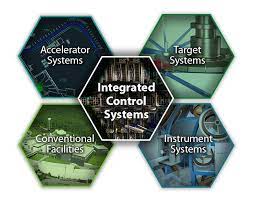Integrated Control Systems: Streamlining Efficiency and Enhancing User Experience
In today’s fast-paced world, where technology plays a pivotal role in our daily lives, the need for seamless control and management of various systems has become increasingly important. This is where integrated control systems step in, offering a comprehensive solution to streamline operations and enhance user experience across different domains.
Integrated control systems bring together multiple subsystems such as lighting, audiovisual equipment, HVAC (heating, ventilation, and air conditioning), security systems, and more into a unified platform. By integrating these disparate systems, businesses and homeowners can enjoy enhanced efficiency, convenience, and improved functionality.
One of the key benefits of integrated control systems is the ability to centralize control. Instead of managing each system individually with separate controls or remotes, users can now have a single interface to monitor and operate all connected devices. This simplifies the user experience by eliminating the need for multiple remotes or complicated processes to adjust settings or manage different components.
Moreover, integrated control systems offer increased automation capabilities. With programmable schedules and intelligent algorithms, users can automate routine tasks based on predetermined settings or triggers. For example, lighting can be programmed to adjust automatically based on natural light levels or specific time periods. This not only saves time but also enhances energy efficiency by optimizing resource usage.
Another significant advantage of integrated control systems is their scalability. Whether it’s a small residential property or a large commercial building with complex requirements, these systems can be customized and expanded as needed. As businesses grow or homeowners’ needs change over time, integrated control systems provide the flexibility to adapt without requiring major infrastructure overhauls.
Furthermore, these advanced control solutions offer enhanced security features. By integrating security cameras, access controls, and alarm systems into the overall system architecture, users gain a holistic view of their premises’ safety status. Real-time monitoring and notifications enable proactive responses to potential threats or emergencies.
From an operational standpoint, integrated control systems provide valuable insights and analytics. By consolidating data from different subsystems, users can gain a comprehensive overview of energy consumption, system performance, and usage patterns. This information can be utilized to optimize resource allocation, identify areas for improvement, and make informed decisions for increased efficiency.
In conclusion, integrated control systems have revolutionized the way we manage and interact with technology in various domains. By centralizing control, automating processes, and offering scalability, these systems streamline operations while enhancing user experience. With their ability to integrate multiple subsystems and provide valuable insights, they are an indispensable tool for businesses and homeowners seeking efficiency, convenience, and improved functionality in today’s interconnected world.
8 Essential Tips for Integrated Control Systems in the UK
- Understand the purpose
- Plan for scalability
- Choose compatible components
- Implement robust security measures
- Provide redundancy
- Regularly monitor performance
- Train personnel adequately
- Keep documentation up-to-date
Understand the purpose
When it comes to integrated control systems, one of the most crucial tips is to understand their purpose. Before diving into the world of integrated control systems, it’s essential to have a clear understanding of what you want to achieve.
Integrated control systems can serve various purposes depending on the context. For businesses, it might be about enhancing operational efficiency, improving security measures, or creating a more user-friendly environment for employees and customers. In residential settings, the focus could be on convenience, energy efficiency, or creating immersive audiovisual experiences.
By defining your goals and objectives from the outset, you can ensure that the integrated control system you choose aligns with your specific needs. This understanding will guide you in selecting the right components and functionalities that will best serve your purpose.
Consider conducting a thorough assessment of your existing systems and identifying areas that could benefit from integration. Are there multiple subsystems that require separate controls? Are there inefficiencies in managing different components? Understanding these pain points will help you prioritize which aspects need integration and automation.
Additionally, consulting with professionals in the field can be invaluable. AV specialists or system integrators can provide expert advice tailored to your requirements. They can help you identify potential challenges and recommend solutions that align with your goals.
Understanding the purpose of an integrated control system also involves considering future scalability and flexibility. As technology evolves rapidly, it’s essential to choose a system that can adapt and grow alongside your needs. Selecting a scalable solution ensures that your investment remains valuable in the long run.
In conclusion, understanding the purpose behind integrating control systems is crucial for successful implementation. By clearly defining your objectives, assessing existing systems, seeking professional advice when needed, and considering future scalability, you can make informed decisions that align with your goals. With this knowledge in hand, you’ll be well-equipped to embark on a journey towards improved efficiency, convenience, and enhanced user experiences through integrated control systems.
Plan for scalability
When implementing integrated control systems, one crucial tip to keep in mind is to plan for scalability. While it’s important to address your current needs, it’s equally essential to consider future growth and potential expansions.
Scalability refers to the system’s ability to accommodate additional devices, functionalities, or users as your requirements evolve. By planning for scalability from the start, you can avoid costly and disruptive upgrades down the line.
When designing your integrated control system, work with experienced professionals who understand your industry and can anticipate potential future needs. They can help you select a scalable system architecture that can easily integrate new components or expand existing ones without major disruptions.
Consider factors such as the number of devices you may need to add in the future, the possibility of new technologies emerging, and any changes in your operational requirements. By incorporating flexibility into your system design, you ensure that it can adapt and grow with your business.
Planning for scalability also involves considering the infrastructure required to support expansion. Ensure that your network infrastructure has sufficient capacity and bandwidth to handle increased data traffic as more devices are added. This may involve investing in robust networking equipment or upgrading existing infrastructure.
Additionally, choose a control system platform that offers flexibility and compatibility with a wide range of devices and protocols. This will allow you to easily integrate new technologies or replace outdated ones without starting from scratch.
By planning for scalability, you future-proof your integrated control system investment. Not only does this save time and money in the long run by avoiding costly retrofits or replacements, but it also ensures that your system remains efficient and effective as your needs evolve.
In conclusion, when implementing integrated control systems, always plan for scalability. By anticipating future growth and considering infrastructure requirements from the start, you can ensure a smooth expansion process without disrupting operations. With a scalable system in place, you’ll be well-prepared for whatever changes lie ahead while maximizing the long-term value of your investment.
Choose compatible components
When it comes to setting up an integrated control system, one crucial tip that should not be overlooked is the importance of choosing compatible components. The success and effectiveness of your integrated control system greatly depend on the seamless interaction between its various subsystems.
Compatibility ensures that all the components within your integrated control system can communicate effectively with each other. This means that they can share information, receive commands, and work together harmoniously to achieve your desired outcomes. When components are not compatible, it can lead to functionality issues, limited capabilities, or even system failure.
To ensure compatibility, it is essential to work with reputable suppliers and manufacturers who provide a range of compatible products specifically designed for integration. They will have tested their components extensively and have documentation or certifications that confirm their compatibility with other systems.
Before making any purchases, take the time to research and understand the compatibility requirements of each component you plan to incorporate into your integrated control system. Look for specifications such as communication protocols, data formats, and software compatibility. Ensure that these requirements align with the existing or planned infrastructure of your system.
Consulting with experts in the field can also be beneficial. They can provide valuable insights into which components are known for their compatibility and offer guidance on building a robust and cohesive integrated control system.
By choosing compatible components from the outset, you eliminate potential headaches down the line. You can be confident that your integrated control system will function smoothly without any hiccups or limitations. This ensures a seamless user experience and maximizes the efficiency and effectiveness of your integrated control solution.
In summary, selecting compatible components is a crucial tip when setting up an integrated control system. It allows for effective communication between subsystems and ensures smooth operation without any compatibility issues. By working with reputable suppliers and seeking expert advice, you can build a reliable and efficient integrated control system that meets all your needs seamlessly.
Implement robust security measures
Implement Robust Security Measures: Safeguarding Your Integrated Control Systems
When it comes to integrated control systems, one crucial aspect that should never be overlooked is security. As these systems become more prevalent in homes, businesses, and public spaces, it becomes increasingly important to implement robust security measures to protect against potential threats and vulnerabilities.
Integrated control systems bring together various subsystems into a unified platform, allowing users to control and monitor multiple devices from a single interface. However, this interconnectedness also means that a breach in one component could potentially compromise the entire system. Therefore, prioritizing security is paramount to ensure the integrity and privacy of your integrated control infrastructure.
To begin with, it is essential to choose reputable manufacturers and service providers when selecting your integrated control system components. Opt for companies that have a proven track record in developing secure and reliable solutions. Thoroughly research their security features, certifications, and encryption protocols to ensure they meet industry standards.
Regular software updates are another crucial aspect of maintaining the security of your integrated control systems. Manufacturers often release updates that address vulnerabilities or add new security features. Keeping your system up-to-date ensures that you benefit from the latest protections against emerging threats.
In addition to software updates, strong passwords play a vital role in safeguarding your integrated control systems. Avoid using default passwords provided by manufacturers and opt for unique, complex passwords that include a combination of letters, numbers, and symbols. Regularly change these passwords and avoid reusing them across different platforms.
Network security is equally important when it comes to protecting your integrated control systems. Ensure that your network is secured with robust encryption protocols such as WPA2 or WPA3 for Wi-Fi connections. Implement firewalls and regularly monitor network traffic for any suspicious activity or unauthorized access attempts.
Physical security measures should not be overlooked either. Ensure that access to the physical components of your integrated control systems is restricted only to authorized personnel. This includes securing equipment rooms, control panels, and wiring closets to prevent tampering or unauthorized access.
Lastly, consider implementing multi-factor authentication (MFA) for added security. MFA requires users to provide additional verification, such as a unique code sent to their mobile device, in addition to their password. This adds an extra layer of protection against unauthorized access.
By implementing robust security measures, you can help safeguard your integrated control systems from potential threats and vulnerabilities. Prioritize the selection of secure components, keep software up-to-date, use strong passwords, secure your network, restrict physical access, and consider multi-factor authentication. With these precautions in place, you can enjoy the benefits of integrated control systems with peace of mind knowing that your systems are well protected.
Provide redundancy
Integrated Control Systems: The Power of Redundancy
When it comes to integrated control systems, one key tip that cannot be overlooked is the importance of providing redundancy. Redundancy refers to having backup systems or components in place to ensure uninterrupted operation in the event of a failure.
In any complex system, there is always a possibility of equipment malfunction or unexpected issues that can disrupt the normal functioning of the integrated control system. This is where redundancy plays a crucial role. By incorporating redundant elements, such as backup power supplies, duplicate controllers, or redundant network connections, you can mitigate the risk of downtime and maintain continuous operation.
Redundancy offers several benefits for integrated control systems. Firstly, it enhances reliability by minimizing single points of failure. If one component fails, the redundant backup takes over seamlessly, ensuring uninterrupted operation and minimizing any potential disruptions. This is particularly important in critical applications such as data centers, healthcare facilities, or manufacturing plants where downtime can have significant consequences.
Secondly, redundancy provides peace of mind. Knowing that your integrated control system has built-in fail-safe mechanisms instills confidence in its reliability and ability to withstand unforeseen circumstances. It gives you the assurance that even if an issue arises, your system will continue to function smoothly without compromising on performance or safety.
Moreover, redundancy can lead to improved maintenance practices. With redundant components in place, maintenance activities can be performed without interrupting ongoing operations. This reduces the need for scheduled downtime and allows for seamless servicing or replacement of faulty equipment while keeping the overall system running smoothly.
It’s important to note that redundancy should be carefully planned and implemented based on specific requirements and risk assessments. The level of redundancy needed may vary depending on factors such as system criticality, operational needs, and budget considerations. Consulting with experienced professionals in the field of integrated control systems can help determine the appropriate level of redundancy for your specific application.
In conclusion, providing redundancy is a valuable tip when it comes to integrated control systems. By incorporating backup systems or components, you can ensure uninterrupted operation, enhance reliability, and minimize the impact of potential failures. Whether it’s for critical facilities or everyday applications, redundancy is a powerful tool that adds an extra layer of protection, offering peace of mind and enabling seamless maintenance practices.
Regularly monitor performance
Regularly Monitor Performance: Optimizing Integrated Control Systems for Maximum Efficiency
When it comes to integrated control systems, one of the most crucial tips for ensuring optimal performance is to regularly monitor their functionality. By keeping a close eye on the system’s performance, businesses and homeowners can identify any issues or inefficiencies early on and take proactive measures to rectify them.
Monitoring the performance of an integrated control system involves several key aspects. Firstly, it’s essential to regularly check the system’s overall functionality. Are all subsystems properly connected and communicating with each other? Are there any error messages or malfunctions that need attention? By conducting routine checks, potential problems can be detected early, preventing them from escalating into more significant issues that could disrupt operations or compromise user experience.
In addition to general functionality, monitoring performance also involves evaluating system efficiency. Integrated control systems offer various features aimed at optimizing energy consumption and resource usage. Regularly reviewing energy usage patterns and analyzing data can help identify areas where improvements can be made to enhance efficiency. Adjusting settings or schedules based on usage patterns can lead to significant energy savings over time.
Another aspect of monitoring performance is ensuring that all software and firmware are up to date. Manufacturers often release updates and patches that address security vulnerabilities, improve functionality, or introduce new features. By regularly checking for updates and applying them promptly, users can ensure their integrated control systems are running on the latest versions, benefiting from enhanced security measures and improved performance.
Furthermore, monitoring performance includes keeping an eye on user experience. Are there any issues reported by users regarding system usability or reliability? Are there any recurring complaints or concerns? Paying attention to user feedback helps identify areas where adjustments may be needed to enhance satisfaction and streamline operations further.
To effectively monitor performance, it’s advisable to establish a regular maintenance schedule. This could involve performing routine checks at predetermined intervals or engaging professional technicians who specialize in integrated control systems for more comprehensive assessments. Regular maintenance not only helps detect and address issues promptly but also ensures that the system remains in optimal condition, prolonging its lifespan and minimizing downtime.
In conclusion, regularly monitoring the performance of integrated control systems is vital for maximizing efficiency and user satisfaction. By conducting routine checks, evaluating energy usage patterns, keeping software up to date, and addressing user feedback, businesses and homeowners can identify potential issues early on and take proactive measures to maintain a smoothly operating system. With regular monitoring and maintenance, integrated control systems can continue to provide seamless control, convenience, and enhanced functionality for years to come.
Train personnel adequately
When it comes to implementing integrated control systems, one crucial tip that should not be overlooked is the proper training of personnel. While these systems offer numerous benefits, their effectiveness heavily relies on the knowledge and expertise of those operating them.
Integrated control systems can be complex, with various components and functionalities that require a thorough understanding. By providing adequate training to personnel, businesses can ensure that their employees have the necessary skills to operate and maximize the potential of these systems.
Training should cover not only the basic functions but also advanced features and troubleshooting techniques. Employees should be familiarized with the user interface, system controls, and protocols for managing different subsystems. This includes learning how to adjust lighting levels, manage audiovisual equipment, monitor security systems, and more.
Moreover, personnel should receive training on how to handle emergency situations or system failures effectively. They need to understand how to identify potential issues, troubleshoot problems, and implement appropriate solutions. This knowledge empowers employees to address any challenges that may arise promptly.
By investing in comprehensive training programs for integrated control systems, businesses can reap several benefits. Firstly, trained personnel will be able to operate the system efficiently and make full use of its capabilities. This optimizes productivity while avoiding unnecessary downtime or delays caused by user errors.
Secondly, well-trained employees can identify opportunities for system optimization or improvements. They can provide valuable insights into how the integrated control system is being utilized in day-to-day operations and suggest adjustments that could enhance efficiency or meet specific requirements.
Additionally, proper training helps mitigate risks associated with security breaches or unauthorized access. Employees who are aware of best practices for maintaining data integrity and protecting sensitive information can play a vital role in safeguarding the system from potential threats.
Lastly, ongoing training is essential as technology evolves rapidly. Regular updates on new features or software enhancements ensure that personnel stay up-to-date with industry advancements and can leverage the latest functionalities offered by their integrated control systems.
In conclusion, training personnel adequately is a crucial tip for successful implementation and operation of integrated control systems. By equipping employees with the necessary knowledge and skills, businesses can maximize the potential of these systems, optimize efficiency, and ensure the security of their operations. Ongoing training programs also help keep personnel up-to-date with technological advancements, enabling them to adapt to changes and continuously improve system performance.
Keep documentation up-to-date
When it comes to integrated control systems, one often overlooked but crucial aspect is keeping documentation up-to-date. Documentation serves as a roadmap for understanding and maintaining the system, ensuring smooth operations and troubleshooting when needed.
Integrated control systems can be complex, involving various components, configurations, and settings. Without accurate and current documentation, it becomes challenging to identify the intricacies of the system or make necessary changes efficiently.
By regularly updating documentation, businesses and homeowners can save time and effort in the long run. When changes are made to the system, whether it’s adding new devices or modifying settings, documenting these updates ensures that everyone involved has access to the most recent information. This reduces confusion and minimizes errors during maintenance or future upgrades.
Documentation also plays a crucial role in troubleshooting. In case of technical issues or malfunctions within the integrated control system, having an up-to-date record of configurations and connections can significantly speed up the resolution process. Technicians can refer to the documentation to understand how different components are interconnected and identify potential problem areas more effectively.
Moreover, keeping documentation up-to-date allows for smoother collaboration between different stakeholders involved in managing the integrated control system. Whether it’s an internal team or external contractors responsible for maintenance or upgrades, having accurate documentation ensures that everyone is on the same page regarding system specifications and requirements.
Regularly reviewing and updating documentation also helps with future scalability and expansion plans. As businesses grow or homeowners’ needs change over time, having detailed records of existing configurations makes it easier to assess compatibility with new devices or subsystems. This saves valuable time during expansion projects by providing a clear understanding of how existing components can integrate with new additions seamlessly.
In conclusion, maintaining up-to-date documentation is an essential tip for effectively managing integrated control systems. It ensures clarity, efficiency, and ease of troubleshooting while facilitating collaboration among stakeholders. By investing time in documenting changes as they occur, businesses and homeowners can reap long-term benefits by simplifying maintenance, troubleshooting, and future system expansions.




